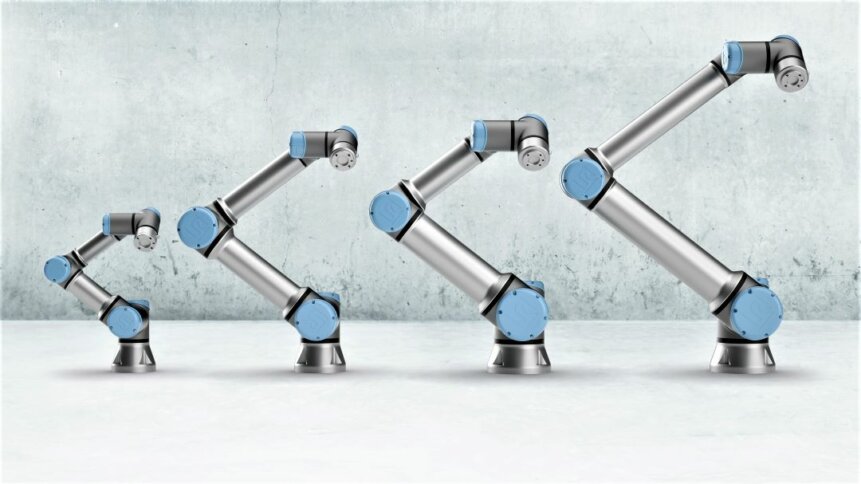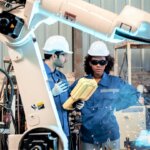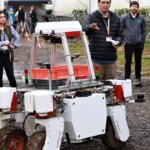What are cobots used for? Robotics trends in 2023

Robots have long made headlines, first in science fiction and then as science fact, as movable electronic devices have grown in sophistication and been put to work in the physical world. And one of the strongest robotics trends in 2023 is the rise of collaborative robots – a class of automated machines dubbed cobots, which are designed to work alongside humans and can accurately perform repetitive tasks.
What are cobots used for?
Today, cobots can be found in numerous industrial settings. They are well-suited to carry out common actions in manufacturing, device assembly, food production and processing, goods packing, and various other commercial scenarios involving repetitive manual work.
Well-known manufacturers of cobots include –
Reporting on the collaborative robotics sector, market analyst IDTechEx has identified at least 30 different cobot developers. Firms offer products ranging from highly integrated high-cost cobots, retailing for more than US $35,000, through to more affordable lower-cost robotics priced at below US $25,000.
And customers can easily try before they buy by hiring cobots – for as little as £65 (approx. US $80) per day, in some cases – based on figures advertised on the web and depending on the device.
Looking beyond what cobots are used for, it’s important to consider the features that have made these machines so successful. Industrial robots have been around for decades, but – for safety – they operate separately from humans and halt for employees. The productivity gain enabled by cobots is their ability to share spaces with staff and collaborate with workers on tasks.
In addition, and emphasizing why cobots are a strong robotics trend in 2023, is how straightforward machines are to program. And once clients understand how to program a cobot they will almost certainly come up with many other ideas on how machines can further automate their operations.
How to program a cobot
Cobots can be fitted with a wide range of peripherals from arc welders to grippers. And units can also be kitted out with additional sensing elements such as machine vision hardware so that cobots can make intelligent decisions based on what’s in front of them.
Customers are becoming increasingly creative in how cobots can be used – for example, San Francisco, US, based Café X uses a US $25,000, 6-axis robotic arm to prepare and serve coffee to customers. And when the unit isn’t busy, it’ll entertain passers-by with a pre-programmed dance.
Enjoy a unique coffee experience with a robotic twist! Cafe X is a robotic coffee bar that offers a variety of drinks for you 24/7.
📍T3 by F4
📍T1 by B20 #SFODining #Coffee #Robots @getcafex pic.twitter.com/00KxDbA8eW— San Francisco International Airport (SFO) ✈️ (@flySFO) June 6, 2023
Another firm exploring the commercial potential of coffee and robots is Chinese firm Shanghai Hi-Dolphin Robot Technology. The developer offers a cobot-staffed drinks stand dubbed COFE+ that can make five cups of coffee in parallel and, according to the firm, units have been exported to the US, Germany, Australia, and Southeast Asia.
Robot baristas highlight cobots versatility. Machines are compact – incredibly so, if you compare cobots to early industrial robots – and capable of carrying out repeatable and precise movements. Cobots are also relatively mobile and can be used to perform different tasks at different locations on the production floor.
Sticking with the food and beverage industry, another trend is the growth in so-called high mix low volume (HMLV) production. Food and drinks producers are exploring a greater variety of products, manufactured at lower volumes, appealing to consumers’ taste for a wider range of goods, but on a similar theme. And this requires a higher level of packaging automation to manage the increased product variety.
“As packaging requires robots with a low payload and high flexibility, it can be an ideal use case for cobots,” write IDTechEx analysts Yulin Wang and James Edmondson in their report, Collaborative Robots (Cobots) 2023-2043: Technologies, Players & Markets.
The future of cobots
Hospitality and healthcare are emerging opportunities for cobots beyond more familiar industrial use cases. And the rise of artificial intelligence (AI) – particularly given the success of advanced chatbots, such as OpenAI’s ChatGPT, powered by large language models (LLMs) – adds another dimension to the future of cobots.
LLMs are already automating knowledge work and it’s interesting to consider the impact those digital tools could have in the physical domain when those smarts are integrated into cobots. Giving robots the capacity to learn tasks for themselves, rather than having to be explicitly programmed, could radically reshape the kinds of jobs that humans will be performing in the future.
For example, in construction remote-controlled equipment already allows just a few workers to assemble large building frameworks. And it’s reasonable to imagine greater use of collaborative robots to extend opportunities for automation, to lower cost, improve safety, and deliver other benefits in construction and elsewhere.
“Faster reaction time, more exact movement patterns, orientation capabilities, capabilities in imitating humans – all these aspects contribute to advancements in cobot development,” comments Elena Fersman – a computer scientist and AI expert based at Ericsson’s Silicon Valley site in the US, and a fellow of the Royal Academy of Engineering Sciences in Sweden. “When brain signals can be read with high precision and transferred to the robots, we will be able to collaborate with them in a completely new way.”
Over the years, AI has been regularly hyped as a game-changer for industry. But predicting when those successes are going to happen has never been easy. However, when AI does take off, it’s hard to ignore – as the current boom in digital automation shows.
In this case, the uptick in productivity is enabled by large language models trained on vast amounts of information scraped from the web, as well as digital repositories of books and academic papers, and with the possibility to be further fine-tuned using business data. And when those learnings cross over into the physical realm, possibly with advanced cobots as a first step, we will witness another huge leap in automation.
Today, in the digital world, generative AI – which includes not just advanced chatbots, but also image creation applications – is impacting multiple professional fields. And the combination of AI and robots will have widespread ramifications for companies and their staff. However, there are greater constraints in delivering physical products compared with software-based solutions.
Returning to the example of cobot-run coffee stalls, Café X CEO and founder Henry Hu reminds the media that it’d take his firm more than 20 years (building 1000 automated kiosks per year) to compete with the number of locations that Starbucks has worldwide today. Even if you have robots building robots there are still time and materials constraints that don’t apply to digital products. And AI cobots, although likely to be highly impactful, won’t be able to proliferate at the same rate as LLM services are currently.











